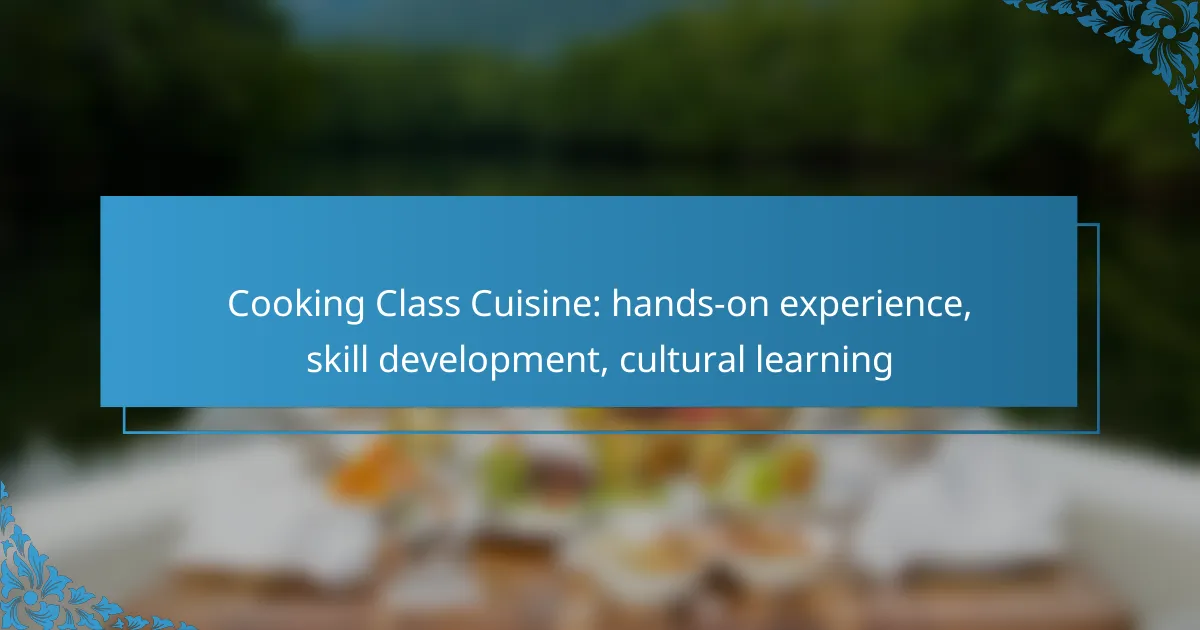Join a cooking class in Los Angeles to immerse yourself in a hands-on culinary experience that enhances your skills while exploring diverse cultural cuisines. These classes not only teach practical techniques and recipes but also provide valuable insights into the cultural significance of each dish, enriching your overall cooking journey.

What are the best cooking classes in Los Angeles?
Los Angeles offers a variety of cooking classes that cater to different skill levels and culinary interests. From hands-on experiences to cultural learning, these classes provide opportunities to develop cooking skills while exploring diverse cuisines.
Sur La Table cooking classes
Sur La Table provides a range of cooking classes focusing on various cuisines and techniques, suitable for all skill levels. Classes typically last around two to three hours and include hands-on instruction, allowing participants to cook and taste their creations.
Expect to pay between $70 to $150 per class, depending on the complexity of the dish and the materials provided. Popular classes include pasta making, sushi rolling, and seasonal cooking.
Los Angeles Culinary Institute
The Los Angeles Culinary Institute offers professional-level training alongside recreational cooking classes. Their programs emphasize skill development in a structured environment, making it ideal for serious culinary enthusiasts.
Classes range from a few hours to several weeks, with costs varying accordingly. They cover topics such as baking, knife skills, and international cuisines, providing a comprehensive culinary education.
Chef Eric’s Culinary Classroom
Chef Eric’s Culinary Classroom focuses on hands-on cooking experiences with an emphasis on technique and flavor. Classes are designed for both beginners and advanced cooks, featuring a variety of cuisines and cooking methods.
Prices generally range from $85 to $150 per session, with options for single classes or multi-class packages. Participants can expect to learn practical skills while enjoying a collaborative cooking environment.
Hands-on Cooking School
Hands-on Cooking School offers immersive cooking experiences that emphasize practical skills and cultural learning. Classes are interactive, allowing participants to engage directly with the cooking process and ask questions in real-time.
Sessions typically cost between $60 and $120, depending on the class length and materials. Popular offerings include ethnic cuisine workshops and seasonal cooking classes, making it a great choice for those looking to expand their culinary repertoire.
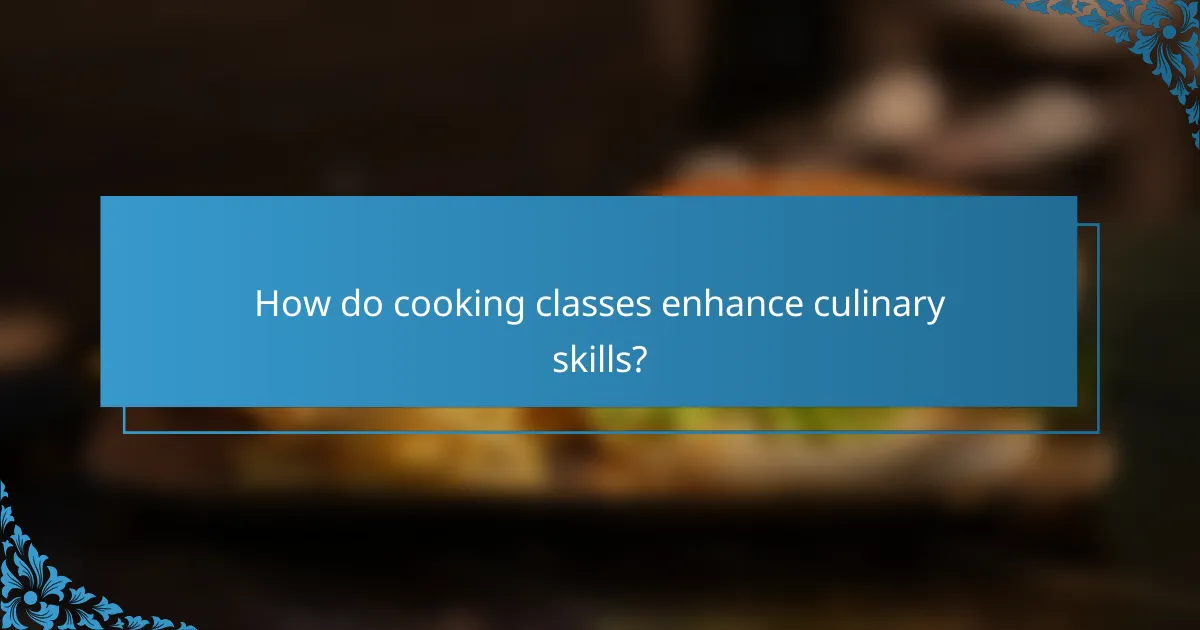
How do cooking classes enhance culinary skills?
Cooking classes enhance culinary skills by providing hands-on experience, fostering skill development, and offering insights into various cultural cuisines. Participants learn practical techniques, develop recipes, and gain a deeper understanding of ingredients, all of which contribute to their overall cooking proficiency.
Practical cooking techniques
Cooking classes focus on practical techniques that are essential for culinary success. Participants often engage in activities such as knife skills, sautéing, baking, and plating, which are crucial for creating appealing dishes. Mastering these techniques can significantly improve efficiency and confidence in the kitchen.
For example, learning how to properly julienne vegetables can enhance the presentation of a dish and ensure even cooking. Classes typically emphasize practice, allowing students to repeat techniques until they feel comfortable and proficient.
Recipe development
Recipe development is a key component of cooking classes, where participants learn to create and modify dishes based on their tastes and available ingredients. This process encourages creativity and experimentation, helping cooks understand flavor profiles and ingredient interactions.
Students might start with a basic recipe and then explore variations by adjusting spices, cooking methods, or ingredient substitutions. This hands-on approach fosters a deeper appreciation for the culinary arts and builds confidence in one’s ability to innovate in the kitchen.
Ingredient knowledge
A thorough understanding of ingredients is vital for successful cooking, and classes often include lessons on selecting, storing, and utilizing various components. Participants learn about seasonal produce, different types of proteins, and the importance of freshness, which can greatly influence the outcome of a dish.
For instance, knowing the difference between fresh herbs and dried ones can affect flavor intensity. Classes may also cover local ingredients, encouraging students to explore regional specialties and adapt recipes to reflect their culinary heritage.
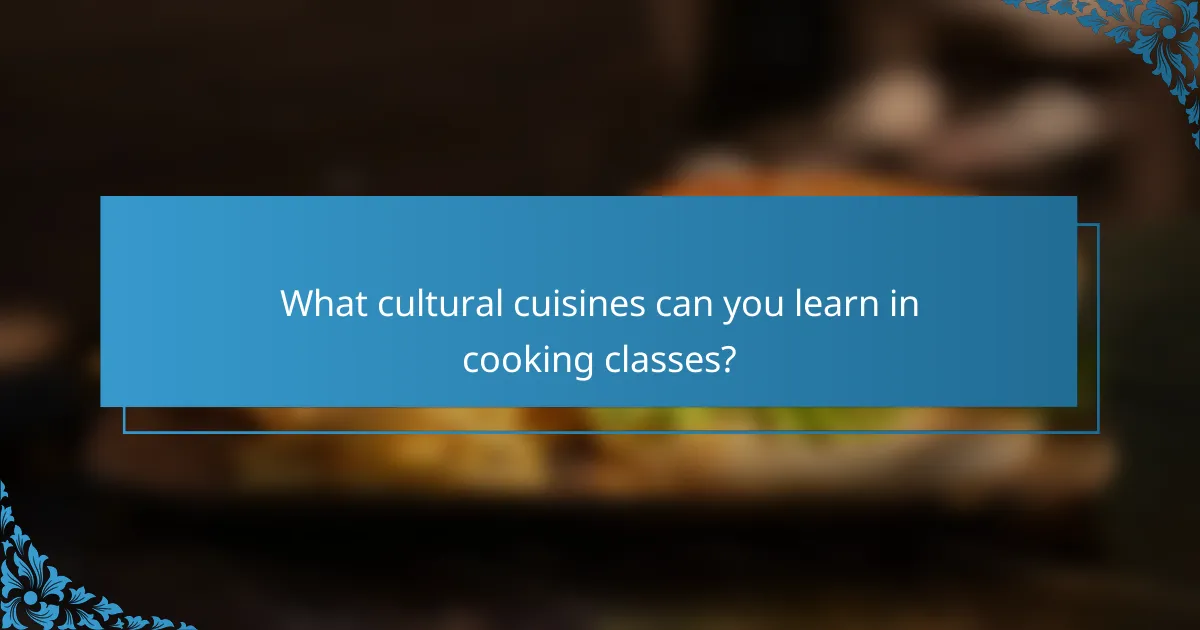
What cultural cuisines can you learn in cooking classes?
Cooking classes offer a diverse range of cultural cuisines, allowing participants to explore various culinary traditions. Through hands-on experience, students can develop skills while gaining insights into the cultural significance of each cuisine.
Italian cuisine
Italian cuisine is renowned for its emphasis on fresh ingredients and simple preparation methods. Common dishes include pasta, risotto, and pizza, each showcasing regional variations and local produce.
In cooking classes, participants often learn to make classic sauces like marinara or pesto, as well as traditional desserts such as tiramisu. Understanding the importance of herbs and olive oil is crucial for authentic Italian cooking.
Mexican cuisine
Mexican cuisine is characterized by its vibrant flavors and use of diverse ingredients like corn, beans, and chili peppers. Popular dishes include tacos, enchiladas, and mole, each reflecting the country’s rich cultural heritage.
In a cooking class, students may explore techniques for making fresh tortillas or mastering salsas. Learning about the balance of spices and the significance of regional variations enhances the cooking experience.
Asian cuisine
Asian cuisine encompasses a wide variety of culinary traditions, including Chinese, Japanese, Thai, and Indian. Each region offers unique flavors and cooking techniques, from stir-frying to steaming and curry-making.
Cooking classes often focus on essential skills like knife techniques, sushi rolling, or the art of balancing sweet, sour, salty, and spicy flavors. Participants gain an appreciation for the cultural context behind dishes such as pho or pad thai.
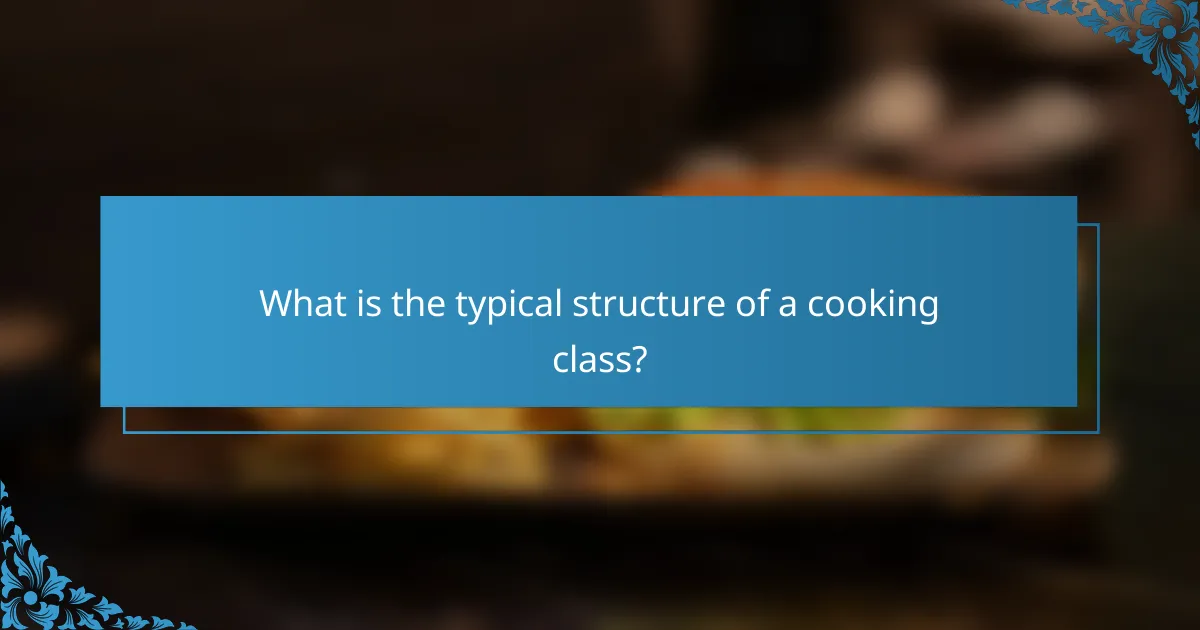
What is the typical structure of a cooking class?
A typical cooking class usually consists of three main components: an introduction and demonstration, a hands-on cooking session, and a tasting and feedback segment. This structure allows participants to learn techniques, practice skills, and receive constructive critiques in a supportive environment.
Introduction and demonstration
The class typically begins with an introduction where the instructor outlines the objectives and the dishes to be prepared. This is followed by a demonstration of key techniques and ingredients, providing participants with a visual understanding of the cooking process.
During this phase, instructors often share tips on ingredient selection, preparation methods, and cooking times. This foundational knowledge is crucial for participants to grasp before they start cooking themselves.
Hands-on cooking session
In the hands-on cooking session, participants apply what they learned during the demonstration. They work individually or in small groups to prepare the dishes, allowing for skill development and experimentation with flavors and techniques.
It’s important to manage time effectively during this segment, as cooking can require precise timing. Participants should be encouraged to ask questions and seek guidance from the instructor as they navigate the cooking process.
Tasting and feedback
The final segment involves tasting the dishes prepared by the participants. This is an opportunity for everyone to enjoy their creations and learn from each other’s experiences. Feedback from the instructor is valuable here, as it helps participants understand what worked well and what could be improved.
Encouraging a supportive atmosphere during tasting fosters a sense of community among participants. They can share their thoughts on flavors, presentation, and techniques, enhancing the overall learning experience.
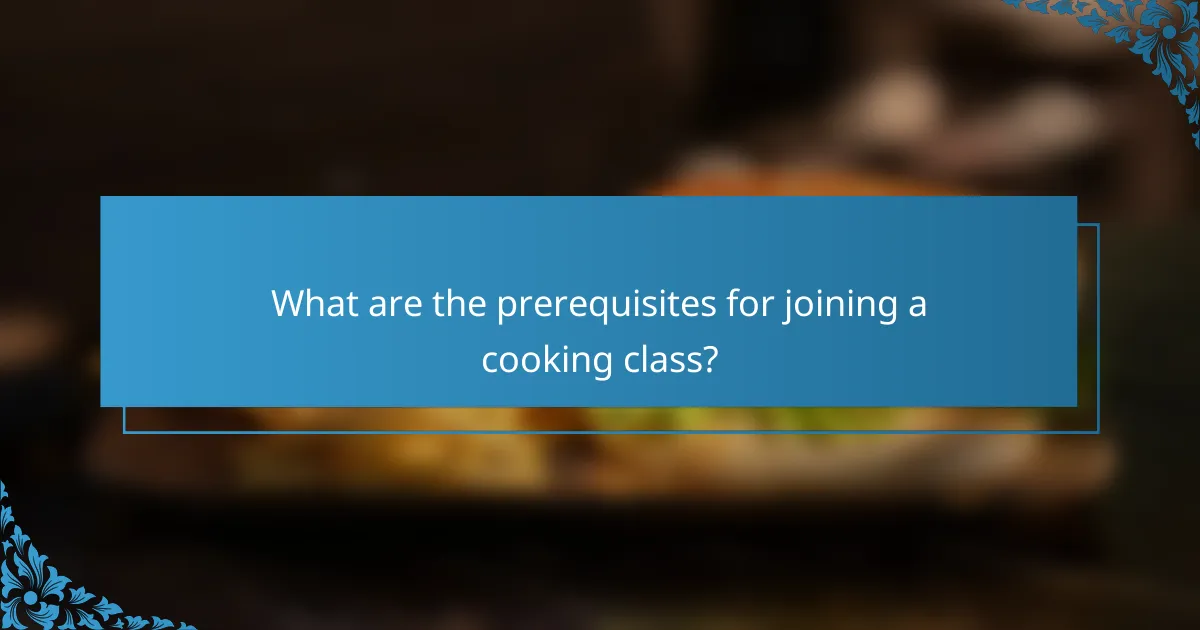
What are the prerequisites for joining a cooking class?
Joining a cooking class typically requires no specific prerequisites, making it accessible to a wide range of participants. However, it is beneficial to consider factors such as prior experience, age, and any dietary restrictions before enrolling.
No prior experience required
Most cooking classes welcome participants with no prior cooking experience. Instructors often tailor lessons to accommodate beginners, focusing on foundational skills and techniques. This inclusive approach allows everyone to learn at their own pace.
For those with some experience, classes can still offer valuable skill development and new culinary techniques. Participants can choose classes that match their skill level, from basic cooking to advanced culinary arts.
Age restrictions
Age restrictions for cooking classes vary by location and institution. Many classes are designed for adults, while others may cater specifically to children or families. Some classes may require participants to be at least 16 years old, while others may allow younger children if accompanied by an adult.
It’s essential to check with the cooking school or instructor regarding their age policies to ensure a suitable learning environment for all participants.
Ingredient allergies
Participants should disclose any ingredient allergies when enrolling in a cooking class. Instructors can often adjust recipes or provide alternatives to ensure safety and inclusivity. This is particularly important in classes that involve hands-on cooking with common allergens.
Before attending, review the class syllabus or menu to identify potential allergens. If necessary, reach out to the instructor for guidance on how to manage allergies during the class. This proactive approach helps create a safe cooking experience for everyone involved.
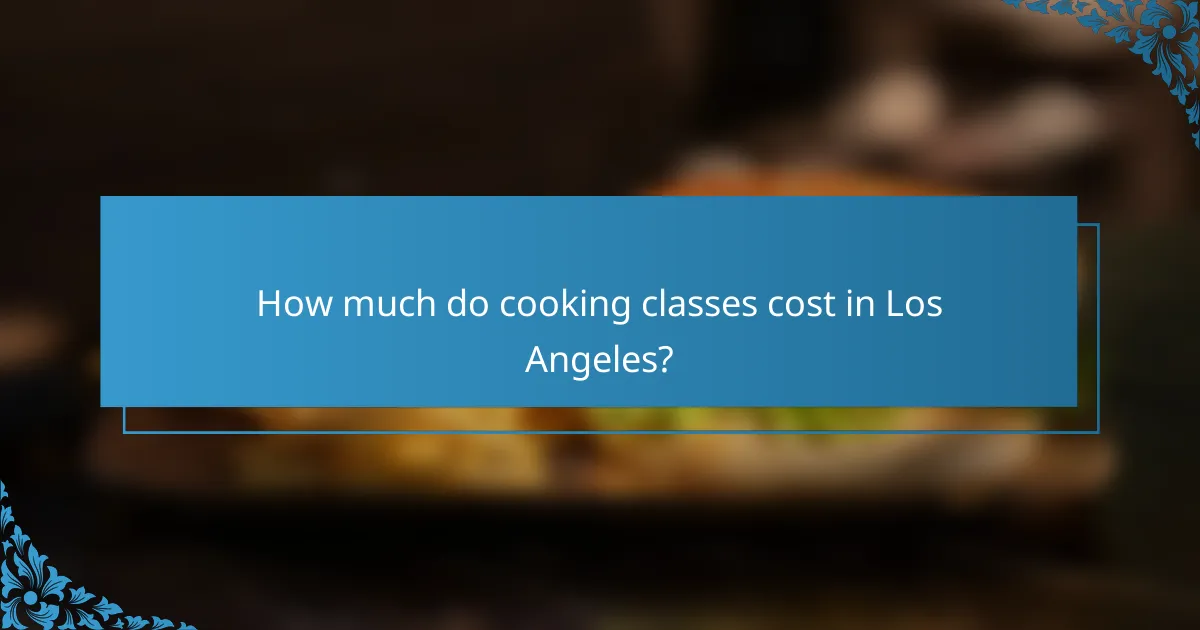
How much do cooking classes cost in Los Angeles?
Cooking classes in Los Angeles typically range from around $50 to $200 per session, depending on the type of cuisine, duration, and instructor expertise. Prices can vary significantly based on the class format, whether it’s a single session or part of a series.
Average price range
The average price for cooking classes in Los Angeles generally falls between $75 and $150 per class. Basic classes focusing on fundamental skills or specific cuisines tend to be on the lower end, while specialized or gourmet classes may reach the higher end of the spectrum.
For example, a hands-on Italian cooking class might cost around $100, while a more advanced pastry course could be priced closer to $175. It’s advisable to check various cooking schools and community centers for their offerings and pricing.
Discounts for group bookings
Booking a private class for a group can also lead to customized experiences, often at a reduced per-person rate. Always inquire about group rates when planning a class, as this can significantly enhance the overall experience while saving money.
